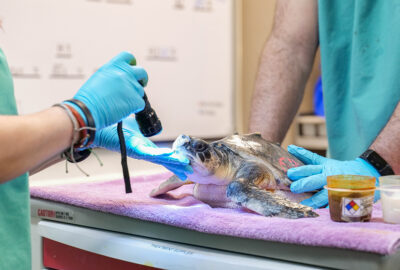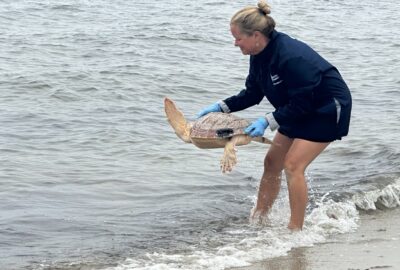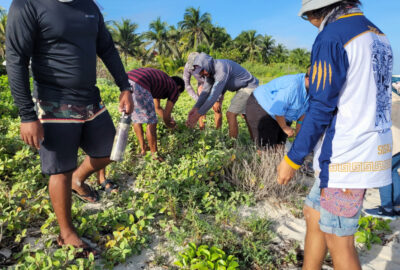Please note: We strongly recommend purchasing tickets online in advance during the heat wave, as our ticket booth is located outdoors.
Sea Turtle Saved After Ingesting Stringed Balloon
By New England Aquarium on Tuesday, January 25, 2022


A cluster of colorful balloons bobbing in the corner at a birthday party or other social gatherings can spark joy and nostalgia for revelers. But when released, these seemingly innocuous items made of rubber, latex, or nylon fabric and their ribbons can wreak havoc on the environment, especially if ingested by animals.
Such is the case for a Kemp’s ridley turtle admitted for treatment at the New England Aquarium’s Sea Turtle Hospital in Quincy, MA, on November 30, 2021. The cold-stunned turtle discovered on the shore of Ellis Beach in Brewster, MA, by Mass Audubon Wellfleet Bay Wildlife Sanctuary staff had ingested a balloon string and was transported to Quincy. The string—or foreign body as veterinarians call it—coursed through the turtle’s body, with a little over 16 inches protruding from its beak and 48 inches hanging out of the cloaca, or posterior opening. Part of the balloon was still attached to the end of the ribbon, already having passed through the turtle’s gastrointestinal tract.
According to data from the International Union for Conservation of Nature, at least 14 million tons of plastic—from water bottles to bags and balloons—ends up in the ocean each year, polluting the water and posing a significant threat to marine animals who often mistake the waste as food.
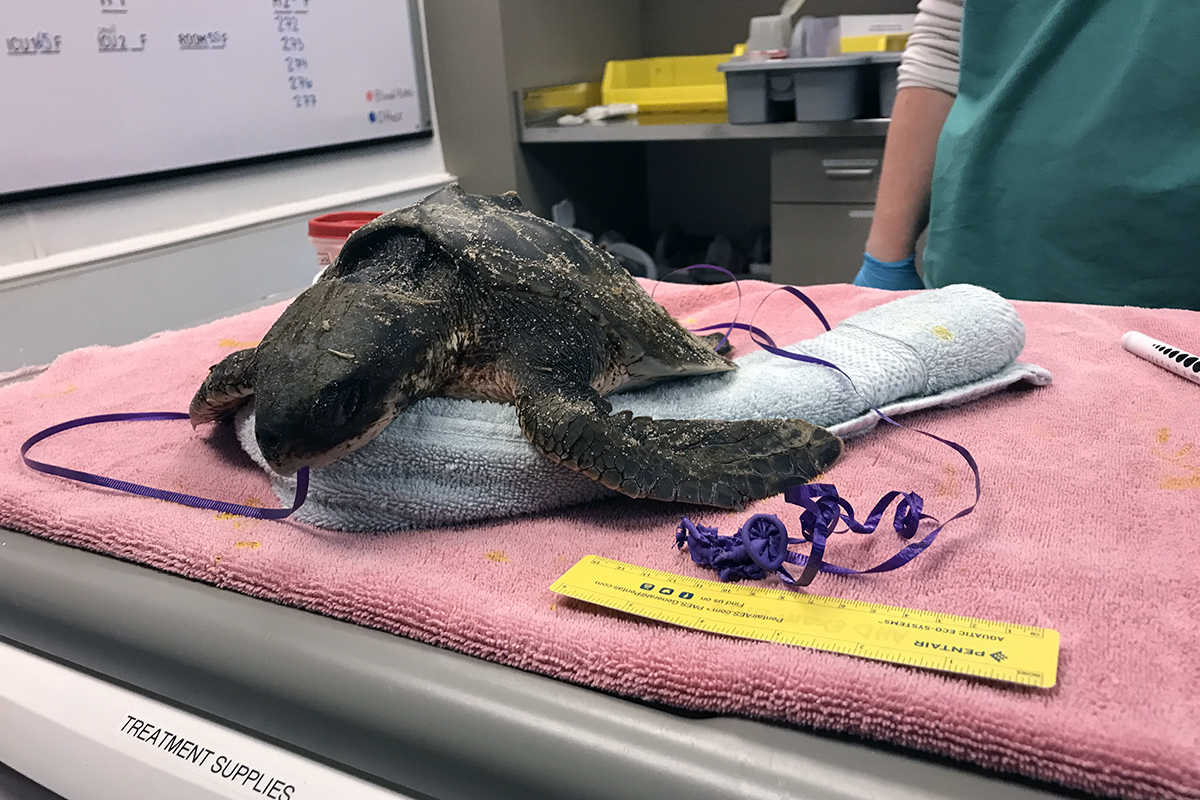
The turtle is seen here with the string passing through its body and a piece of the purple balloon still attached.
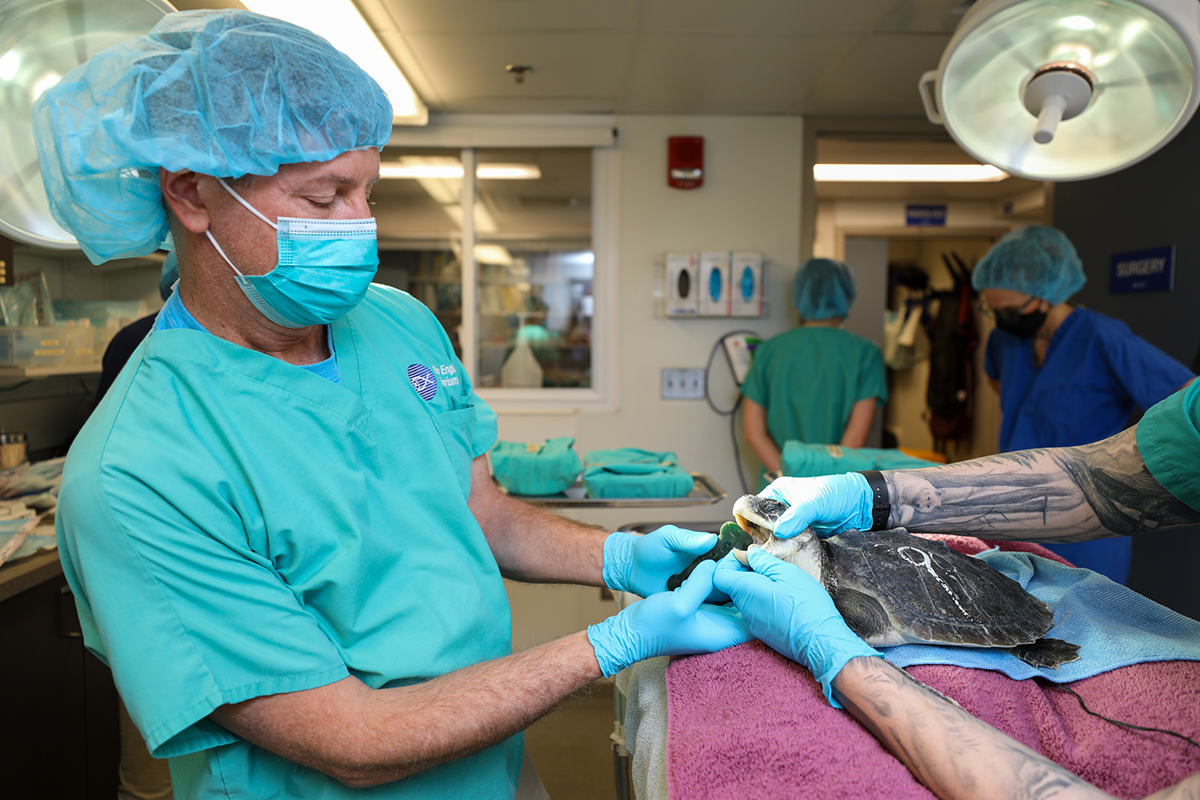
The veterinary team begin prepping the turtle for surgery.
Though the ingestion of foreign bodies is quite common (think dogs gobbling up a favorite shoe or cats eating tissue paper), when the object ingested is a string, it can be hazardous, says the New England Aquarium’s Director of Animal Health, Dr. Charles Innis.
“When the foreign body is a string, we call it a linear foreign body,” Innis explains. “These are quite dangerous. As the intestine contracts along the string, it gets bunched up like the top of a curtain.”
As the tension of the string increases in the bunched intestine, the string can begin to cut through the intestinal wall. Innis shares that if the ribbon cuts through the intestine entirely, the intestinal contents leak into the body cavity, causing severe damage, infection, and sometimes death. In some cases, sections of the intestine have to be removed surgically because of the damage. Other times the damage is so severe that the patient must be euthanized.
Upon arrival, the hypothermic, anemic turtle was examined immediately, and the extraneous ribbon was trimmed from the turtle’s beak and posterior by Animal Health and Rescue staff, says Adam Kennedy, the Aquarium’s manager of Rescue and Rehabilitation.
But, Innis points out, “We had to stabilize it for about a week before we felt comfortable enough to anesthetize it for surgery. First, the turtle was treated with fluid therapy, antibiotics, nutritional support, and gradual warming.”
By December 8, the small Kemp’s ridley was ready for the surgery performed by Drs. Melissa Joblon and Kathy Tuxbury.
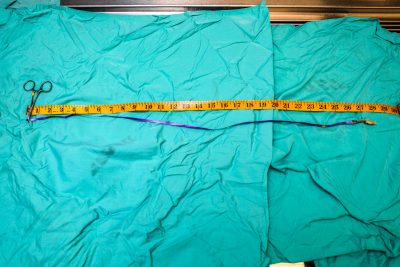
“The team of doctors started with an enterotomy, or incision into the intestine,” Innis says. From there, roughly 28 inches of string (pictured at right) was withdrawn, he explains. Fortunately, the animal’s intestine wasn’t severely damaged.
After a successful surgery, Kennedy says, “The turtle started eating right away post-surgery, but we had to limit his consumption to avoid creating surgical site complications.”
Overall, the Kemp’s ridley ingested a 92-inch long ribbon. This successful surgery marks the end of the third-busiest cold-stunning season where more than 500 turtles were rescued and rehabilitated.
The healthy Kemp’s ridley turtle will be released into the ocean off the Cape this summer.
The rescued Kemp’s ridley turtle swimming post surgery.

